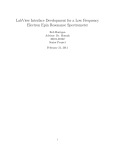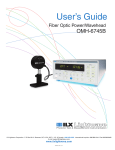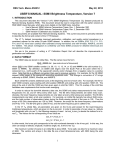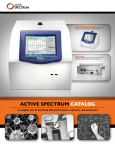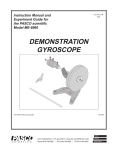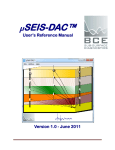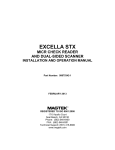Download Experiment 4 ()
Transcript
CHEM 4525: Physical Chemistry Laboratory I Experiment 4 Experiment 4 – Electron Spin (Paramagnetic) Resonance Spectroscopy 1. Objectives 1) Review of concept of electron spin and the quantum mechanical formalism for its treatment 2) Introduce the spin resonance technique and basic experimental setup 3) Understand the principle of operation and practice using modern digital oscilloscope to determine the magnitude of the static magnetic field and resonance frequency. 2. Background 2.1. Electron spin The phenomenon of electron spin was first observed in 1922 in the famous Stern-Gerlach experiment. The discovery and subsequent explanations ultimately gave rise to the field of Magnetic Resonance Spectroscopy. The first electron spin resonance spectrum was successfully obtained in 1944. The main result of the initial experiment was that electrons have an intrinsic magnetic field that is assigned a “spin quantum number,” s, of ½. This quantum number gives the electron and the atom (or compound) it is in a certain amount of angular momentum, S. The charge and the angular momentum of the electron may give the chemical species a magnetic field that can interact with an externally applied magnetic field. The specific chemical species may have one or more unpaired electrons, and are referred to as free radicals (generally, if only one unpaired electron is present) or as paramagnetic species. When multiple unpaired electrons are present, the net spin magnetization is related to the sum of the values of s for the individual electrons. Since angular momentum, S, is a vector quantity, the x-, y-, and z-components of the total spin angular momentum for an electron can only take on certain very specific values. It can be shown that only the total spin and one component can be exactly known simultaneously. For convenience, we choose the zcomponent, i.e. Sz, as the one we will be interested in. The quantum number for the z-component is ms. Each electron can have an ms value of either ±½. It is easy to be confused, at this point, about the x- and y-components. If the total s is ½ and ms is ±½, what is left for the other two directions? The answer is based on the quantum mechanical result that the TOTAL squared spin angular momentum, S2, is [1]: S 2 = s(s +1) 2 (1) Therefore, for a single electron: S 2 S x2 S y2 S z2 ( S x2 S y2 ) (m s ) 2 s ( s 1) 2 ( S x2 S y2 ) ( 12 ) 2 12 ( 12 1) 2 ( S x2 S y2 ) 14 2 34 2 (2) ( S x2 S y2 ) 24 2 12 2 This extra bit of angular momentum cannot be exactly attributed to either Sx or Sy, so we envision it being distributed over all possible values of Sx and Sy that combine to give the correct total value. This gives rise to the angular momentum diagram give in Figure 1: 1 CHEM 4525: Physical Chemistry Laboratory I Experiment 4 Figure 1: Spin Angular Momentum for a single electron. 2.1. Electron spin resonance The concept of a “resonance” in spectroscopy is very similar to resonance in acoustics. A sound (a vibration through a gas) can be made to sound louder and last longer (i.e. enhanced) by coupling it to another vibration (for example, in the material comprising a musical instrument). In spectroscopy, the feature that is enhanced is the signal corresponding to some energy transition. In the ESR technique, the coupling is done between the ms = +½ to the ms = –½ transition and an external magnetic field that decays to a particular orientation. The magnetic moment of the electron, µ, interacts with an external magnetic field, B0, according to (electron Zeeman energy): (3) E g e ms µB B0, z The transition from ms = +½ to –½ involves a decrease in energy in the amount of: E g e µB B0, z (4) In both equations, the product of the electron g-factor (Zeeman splitting constant) and the Bohr magneton, µB, are used instead of the total magnetic moment since we are only interested in the z-component. In fact, the external field is chosen to be in the z-direction. For reference, the value for ge is 2.0023 for a free electron and µB = (eh/4πme) = 9.274x10–28 J/gauss. (Note, the value of ge depends on the chemical environment of the electron.) In some cases, the gyromagnetic ratio, , is used instead of ge and µB since they are related by g e µB (5) As implied by eqn. 4, the relative splitting between the two spin levels depends on the strength of the external magnetic field, B0. Therefore, the stronger the magnetic field, the more sensitive the technique. However, we can divide the external magnetic field into two components: the applied magnetic field and the intrinsic (nuclear) magnetic field. The nuclear spins will couple to the electron spins giving rise to what is referred to as the hyperfine splitting. This effect depends on the actual nucleus the electron is coupling 2 CHEM 4525: Physical Chemistry Laboratory I Experiment 4 to. In cases where the unpaired electron is delocalized in a compound, each nucleus will exhibit its own unique hyperfine structure. We will return to this point later. The resonance effect adds another feature to the process. Besides the z-oriented applied magnetic field, an additional magnetic field is applied perpendicular to this field. Furthermore, this perpendicular field, B1, is allowed to precess (rotate) about the z-axis at a frequency 1. Recall that the overall electron magnetic moment due to the total spin angular momentum is essentially precessing about the z-component (see Fig. 1), we can attribute to this precession a frequency, 0 (known as the Larmor frequency). When the external B1 precesses at the same frequency as the electron’s magnetic field does, the two are in resonance (i.e. when 1=0) and the transition between the two ms states becomes more prominent. Figure 2: Larmor Precession in Resonance 2.3. Boltzmann statistics Under normal conditions, we expect the populations of the two spin states of an electron to be equal because they are energetically identical. In the presence of the magnetic field, B0, the state that is parallel to the field (by convention, this is the ms = +½ state) is more stable. The populations follow the expected Boltzmann distribution [1]: n ms 1 2 n ms 1 2 E m 1 E ms 1 2 exp s 2 k BT exp k BT (6) where the frequency, , is for the transition defined in eq. 4. Since this depends on the external magnetic field, at higher values of B0 the separation between the levels is greatest, meaning the lower energy state is significantly more populated at lower temperatures. In these cases, observing the transition from high energy to low energy is very difficult since the population at the higher energy level is low. On the other hand, absorption of energy from the lower level to the higher is possible. Once this occurs, the emission of energy during the relaxation process is readily observed. Most ESR spectrometers have a built in sensitivity gauge that adjusts the power supplied to the magnetic field being used that tells you how large the ratio of state populations needs to be to observe a transition. The additional power makes the sensitivity higher, so population difference can be smaller. This is a technical/operational point, but it seems worth mentioning it since it relates directly to the population distribution. 3 CHEM 4525: Physical Chemistry Laboratory I Experiment 4 2.4. Hyperfine splitting The presence of non-zero nuclear spins, I ≠ 0, in the free radical or paramagnetic compound create small local magnetic fields in the environment of the unpaired electrons. Depending on the absolute spin states (MI = + or –, for example, where MI is the quantum number for the z-component of the nuclear spin angular momentum, I) of the nuclei, the two electronic spin states will be “split” even in the absence of the external magnetic field. This phenomenon was observed in hydrogen atomic spectra, which is where the term “hyperfine” was originally used. Additionally, each nucleus can be in one of its MI states, and the collective effect will depend on the overall spin state. This produces a more complicated spectrum for the electron spin transition observed in ESR. Each possible nuclear spin arrangement contributes a local magnetic field within which the electron spin flip occurs. For example, if we consider the dihydrogen radical (and ionic) molecule, H•H +, each of the hydrogen atoms has a spin of I = ½, so each can have either MI = ±½. Therefore, labeling one of the atoms A and the other B, we have the following 4 combinations: M I , A 12 , M I ,B 12 M I , A 12 , M I ,B 12 M I , A 12 , M I ,B 12 (7) M I , A 12 , M I ,B 12 Summing up these for possibilities, we get: M I ,total1 M I , A M I , B ( 1 2 ) ( 1 2 ) 1 M I ,total2 ( 1 2 ) ( 1 2 ) 0 M I ,total3 ( 1 2 ) ( 1 2 ) 0 (8) M I ,total4 ( 1 2 ) ( 1 2 ) 1 Since there are two combinations that give rise to MI = 0, we expect 3 different signals for the transition, one for each value of MI. This type of signal is referred to as a “triplet.” We also expect that the ratio of transitions corresponding to each value of MI should be 1:2:1, corresponding to the number of combinations that give rise to these values. Figure 3: A Triplet ESR Signal The distance between the peaks depends on the hyperfine coupling factor, ai, between the electron spin and the particular nuclear spin: E hyperfine a j M S M I , j j 4 (9) CHEM 4525: Physical Chemistry Laboratory I Experiment 4 If the two spins are separated by a great distance their coupling tends to be small. Therefore, if many different nuclei couple their spins to the electron spins, complicated splitting patterns can arise. But, as long as the splitting is distinctive it is possible to make interpretations relating to the structure of the paramagnetic compound. The unusual peak shape shown in Figure 3 is the common way ESR spectra are presented. Instead of the normal peak, the first derivative peak is given. One reason for this convention is that the derivative peak tends to be “taller” than the ordinary peak, so it is easier to see when the signal is weak. Another reason is that it is easier to see anisotropy in the first derivative (i.e. an asymmetrical broadening of the peak). Lastly, the background noise in the signal is often removed when the derivative is applied. 3. Experimental 3.1. The spectrometer The experimental setup of an ESR spectrometer is somewhat simpler than an NMR spectrometer, but we will use a premade device, nonetheless. However, it is good to know something about the machinery so it is not just a “black box” that you put your sample in and flip the switch! Of course, much of the electronic details will be omitted since none of us are electrical engineers! Figure 4: Block Diagram of ESR/EPR Experimental Setup [2]. The sample is placed between a pair of Helmholtz coils that have a current running through them. The current generates a magnetic field through the center of the coils, which acts as the external magnetic field, B0, for the paramagnetic sample. Additionally, the sample tube is wrapped in an induction coil that is hooked up to a radio frequency (RF) generator. This creates the z-directional magnetic field, B1, which gives rise to the Larmor precession described earlier. By adjusting the secondary RF generator in the vicinity of the sample one can observe interference between the Helmholtz coils and the RF generator. This is maximal when the two are at the same frequency, which is when the oscilloscope displays a “beating” pattern. With careful tuning of the RF generator one can obtain the exact value for the Larmour frequency of the paramagnetic electrons. We will not need to be that accurate. The control panel has two knobs that need to be explained. The first is the “sensitivity” knob. Simply put, this adjusts the height of the output signal, i.e. it is an amplifier. For very weak signals, increasing the sensitivity will allow us to see the peaks that would otherwise not be seen. Unfortunately, the noise signal 5 CHEM 4525: Physical Chemistry Laboratory I Experiment 4 (i.e. the unwanted, extraneous signals) are also amplified. In our case, the signal is strong enough that the amplified noise does not affect the results too much. The second knob, labeled “phase” in Figure 4, is a little more difficult to explain. The output from the ESR spectrometer is from the Helmholtz coil and the induction coil. These two outputs are fed separately into the oscilloscope, and each one is amplified separately within the scope. This process causes a phase shift that did not exist in the original signal. The result is that extra images (“ghosts” or “aliases”) appear on the screen of the oscilloscope. To correct this, the phase knob on the control unit introduces a phase shift in the opposite direction, which is compensated by the scope. The result is that the correct number of peaks appears. 3.2. Experimental design The objective of the experiment is to determine the ge factor (eqns. 3 – 5). It can be calculated from eqn. (4) by measuring both the static magnetic field B0,z and the resonance frequency or, equivalently, ). The sample you will be studying is the stable radical shown in Figure 5: 2,2-Diphenyl-1-Picrylhydrazyl (DPPH) radical. Figure 5: 2,2-Diphenyl-1-Picrylhydrazyl (DPPH) Radical 1. Connect the Helmholtz coil with sample to the controller as indicated in Fig. 4. Turn the controller and the oscilloscope on. Set the frequency on the controller (by turning the “Frequency” - Fig. 4) to dead center and the current (by turning the “Current” knob) to 100 mA. Hook up the oscilloscope and turn it on. On the screen you should see a series of peaks (Figure 6). The peaks are if fact absorption dips that come from the magnetic field being modulated at 50 Hz and comes in and out of resonance with the sample. When in resonance, the power gets absorbed by the sample and a “dip” occurs (the reason it appears as a peak is due to the circuitry in the controller which need not concern us too much). If you don’t see peaks, you need to adjust the oscilloscope settings until you do. The settings that need to be adjusted are the time base (it should be compatible with the 50 Hz modulation frequency – see problem 7) and the trigger settings. You can also adjust the sensitivity to optimize the magnitude of the signal, position and offset to optimally fill the screen etc. Try changing the scope settings around to see what effect they have on the displayed curve. 2. The peaks come in “pairs of pairs” (Fig. 6), some closer together some farther apart. Adjust the oscilloscope settings so that you see five peaks. Five peaks should be the full period of the oscillation. Record the time interval between the first and fifth peak. Then change the horizontal scale and position to have two of the more distant peaks at equal distance from the center and with maximum signal/noise 6 CHEM 4525: Physical Chemistry Laboratory I Experiment 4 ratio. Measure the separation between the two peaks in proper units (note the time interval per division on the scope). Figure 6: Schematic illustration of resonance peaks arising from the magnetic field modulation. When the peaks are positioned to be equidistant from the center of the oscilloscope screen (double dashed line) the magnetic field at resonance can be determined from their separation and the peak-to-peak value Bp2p of the magnetic field. 3. Connect the RF generator (Figure 3). Turn the knob on the generator until you see “beats” on the oscilloscope, i.e. high frequency oscillations. Write down the frequency on the dial – this is your resonance frequency. 4. Do not touch the frequency knob, but change the current to 140 mA. Repeat step 2 and record the separation between the peaks. You can check that the resonance frequency remains unchanged. Repeat for currents of 180 and 220 mA. Warning: currents over 200 mA should not be used for extended time periods as they may damage the coil ! Record your data as quickly as possible and turn the current back down to 100 mA. 5. Turn the frequency knob one notch to the left. Repeat steps 2 – 4. 6. Turn the frequency know two notches to the right (one past center). Repeat steps 2 – 4. 4. Data analysis You recorded sets of data for three different resonance frequencies and for each four different current settings that can be used to determine the static magnetic field. You will use linear regression – repeatedly – to 1) calibrate the magnetic field based on your peak separations and 2) to determine the g-factor from these field values corresponding resonance frequencies that you also measured. 1. Calibration of the static magnetic field. The B0 depends on the current flowing through the coils as well as some of the physical characteristics of the coils. The root-mean-square (rms) value is given as follows: 7 CHEM 4525: Physical Chemistry Laboratory I Brms Experiment 4 32 n I 10 125 a ( gauss) (10) where n = Number of turns per coil (500 in our case), a = Radius of the coil (7.7 cm in our case), I = Coil current (in units of amps). The constant in front of the nI/a term comes from the position of the sample between the coils, the magnetic permeability and the particular units being used (in this case, we are measuring the field in gauss). The peak-to-peak value is related to the rms (see problem 9) as: B p 2 p 2 2 Brms ( gauss) (11) From the knowledge of peak-to-peak value positions of the absorption peaks (Figure 6) the actual value of the B0 at resonance with , can be determined. First find the exact frequency of the field oscillation ν (it should be close to 50 Hz). It is related to the spacing between the first and the fifth peak that you measured (problem 10). Now using the positions of the two peaks left and right of center, the magnetic field value at resonance is (problem 11): B0, z B p2 p 2 sin t ( gauss) (12) where ν is your frequency of oscillation and t is the separation between the peaks on the oscilloscope. Equations (10) – (12) can be combined, giving: B0, z 32 2 n I sin t 10 125 a ( gauss) (13) rearranging: 10 125 a 1 B0, z (14) sin t 32 2 n I From (14), plotting the sin( t), with the proper values of andt, versus 1/I is a straight line with the slope that is proportional to B0,z. Use this fact to determine B0,z from the slope of linear regression according to eqn. (14) for each value of the resonance frequency. Note that eqn. (14) has no intercept – use this fact when you set up your linear regression. 2. Calculation of the ge factor. Now you have three values of the resonance frequency 0 and corresponding three values of the static magnetic field B0,z. Use equation (4), properly rearranged to find the value of ge from the slope of the linear regression. Be particularly careful about units. Do not forget to include estimated errors. Compare your calculated value to the known value of the ge factor for the free electron and discuss the level of agreement, discrepancies etc. References: 1. Any Physical Chemistry/Quantum Chemistry Text, e.g. Peter W. Atkins, Julio de Paula and Ronald Friedman: “Quanta, Matter and Change: A Molecular Approach to Physical Chemistry”, W. H. Freeman and Co., New York, 2009. 2. Electron Spin Resonance Spectrometer, Model ESR-104, User’s Manual. SES Instruments Pvt. Ltd., Roorkee, India 8 CHEM 4525: Physical Chemistry Laboratory I Experiment 4 Prelab quiz questions 1. To observe an EPR (ESR), one needs a molecule with an unpaired electron. i.e. a radical. Why is it not possible to observe the EPR for a molecule where all electrons are paired up? 2. Most molecules are not radicals, which means very few will actually give any kind of EPR signal. Why are radicals rare? 3. a) What is the SI unit for the magnetic field? What is the conversion factor between this unit and gauss? b) Find the value of Bohr magneton in standard (SI) units. 4. You put a molecule with a single unpaired electron in a static magnetic field B0 and observe that the resonance occurs at particular frequency of the RF field B1. If you double the field B0, the frequency will: a) increase by a factor of s(s+1) = ¾ b) decrease by a factor of s(s+1) = ¾ c) double d) be reduced by half e) quadruple f) Impossible to tell without knowing the value of the gyromagnetic ratio 5. If the static magnetic field B0 doubles, the ratio of the populations of energy levels with ms=+1/2 and ms = −1/2 will: a) double b) increase by a factor of e2 c) increase, but it is not possible to tell exactly by how much without knowing the resonance frequency and temperature d) decrease, but it is not possible to tell exactly by how much without knowing the resonance frequency and temperature e) decrease by a factor of two f) decrease by a factor of e2 6. Two common EPR “wavebands” X and W correspond to the magnitude of the magnetic field (B0) of 0.33 and 3.5 T (T = Tesla). Calculate the ratio of the populations of states with ms=+1/2 and ms = −1/2 for these two fields at: a) 300 K b) 4 K Which experiment do you expect to give a higher EPR signal, the X or W band one? At which temperature do you expect to see a higher EPR signal, 300 or 4 K? 7. How many peaks will you see in an EPR spectrum and what would be their intensity ratios if a single unpaired electron interacts with: a) a single nucleus with spin of ½ ? b) a single nucleus with spin of 1 ? c) two nuclei, one with spin of ½ and the other with spin of 1 ? 8. What time period (period of oscillation) corresponds to the frequency of 50Hz? The range of the time axis on the oscilloscope is usually set as time per division. Assume your oscilloscope has 10 main divisions on its display (i.e. the time interval displayed is divided into 10 parts). Let’s say, you have the following setting available for time-per-division: 100 ns, 250 ns, 500 ns, 1 μs, 2.5 μs, 5 μs, 10 μs, 25 μs, 50 μs, 100 μs, 250 μs, 500 μs, 1 ms, 2.5 ms, 5 ms, 10 ms, 25 ms, 50 ms, 100 ms, 250 ms, 500 ms, 1 s, 9 CHEM 4525: Physical Chemistry Laboratory I Experiment 4 2.5 s, 5 s, 10 s. What setting would you need to use for time-per-division to best observe one full waveform on the scope screen? 9. Show that for a sine wave the relationship between the root-mean-square (r.m.s.) magnitude and peak to peak value is given by eqn. (11). (Hint: r.m.s. is the mean=average of the square of the function over a given interval. e.g. one period of oscillation). 10. Show that the distance between the first and the fifth peak that arises due to the modulated field passing through resonance (Fig. 6) corresponds to one full period of oscillation. 11. Based on the instrument setup and sine modulation (Fig. 6) prove that the magnitude of the magnetic field at resonance, B0, can be obtained from the peak-to-peak value using equation (12). How do you have to set the oscilloscope (e.g. the time axis range, peak positions) so that you can use eqn. (12) to determine the field? 12. If you increase the current that passes through the Helmholtz coils by a factor of 1.5, the peak-to-peak value of the magnetic field (Bp2p) will: a) increase by a factor of 1.5 b) decrease by a factor of 1.5 c) increase by 1.5(1.5+1) =3.75 d) decrease by 1.5(1.5+1) =3.75 e) increase by 1.5(1.5 1) 1.94 f) decrease by 1.5(1.5 1) 1.94 g) stay the same 13. If you increase the current that passes through the Helmholtz coils by a factor of 1.5, the value of the magnetic field that corresponds to the resonance frequency (B0) will: a) increase by a factor of 1.5 b) decrease by a factor of 1.5 c) increase by 1.5(1.5+1) =3.75 d) decrease by 1.5(1.5+1) =3.75 e) increase by 1.5(1.5 1) 1.94 f) decrease by 1.5(1.5 1) 1.94 g) stay the same 14. If you increase the current that passes through the Helmholtz coils by a factor of 1.5, but you don’t tough the Frequency knob, the resonance frequency will: a) increase by a factor of 1.5 b) decrease by a factor of 1.5 c) increase by 1.5(1.5+1) =3.75 d) decrease by 1.5(1.5+1) =3.75 e) increase by 1.5(1.5 1) 1.94 f) decrease by 1.5(1.5 1) 1.94 g) stay the same 15. Your experiment will consist of (true/false): 10 CHEM 4525: Physical Chemistry Laboratory I Experiment 4 a) Varying the current from 100 to 220 mA for three different settings of the Frequency dial. Each of the current settings will result in a different resonance frequency. b) Varying the Frequency settings for two current values 100 and 220 mA. Different Frequency settings do not affect the resonance frequency. c) Varying the current from 100 to 220 mA for three different settings of the Frequency dial. Each of the current settings will give the same resonance frequency, but different Frequency settings will; change the value of the resonance frequency. 16. True/False a) After measuring the resonance at highest current (220 mV), we will leave the current set to this value for as long as possible, so that we burn the coil and destroy the instrument. b) After measuring the resonance at highest current (220 mV), we will turn the current back down immediately, so that we burn the instrument does not get damaged. 11













